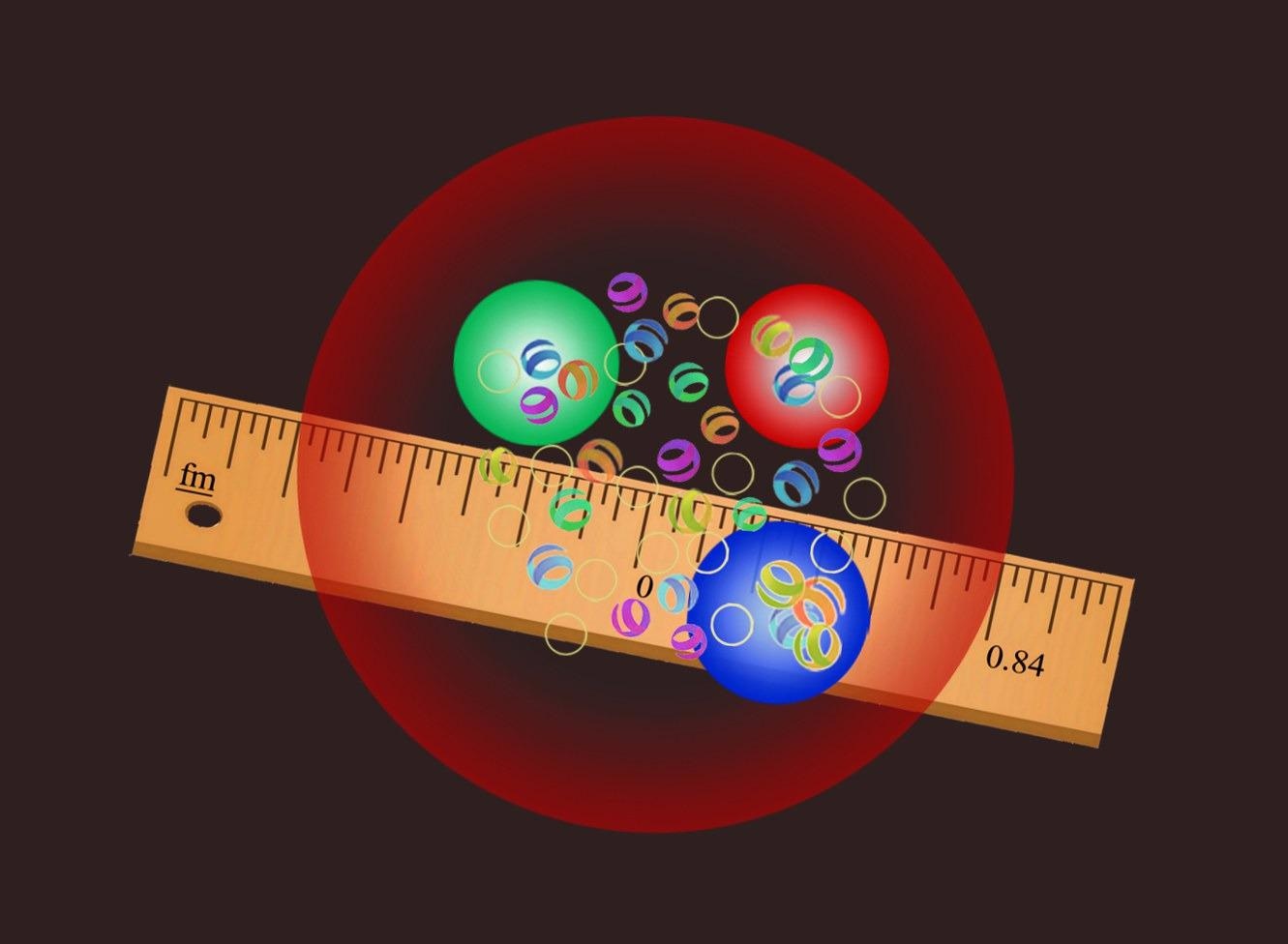Reviewed by Alex SmithFeb 7 2022
Some years ago, a unique measurement method demonstrated that protons are possibly smaller than had been believed since the 1990s. The inconsistency astonished the scientific community; some scientists even felt that the Standard Model of particle physics would have to be altered.
 The proton (red) - has a radius of 0.84 femtometers (fm). Also shown in the figure are the three quarks that make up the proton and the gluons that hold them together. Image Credit: © Dr. Yong-Hui Lin/University of Bonn.
The proton (red) - has a radius of 0.84 femtometers (fm). Also shown in the figure are the three quarks that make up the proton and the gluons that hold them together. Image Credit: © Dr. Yong-Hui Lin/University of Bonn.
Physicists at the University of Bonn and the Technical University of Darmstadt have recently formulated a technique that enables them to examine the results of older and more recent experiments much more in-depth than previously possible.
This also causes a reduced proton radius from the older data, suggesting there is perhaps no variance between the values—regardless of which measurement technique they are based on. The study has been published in Physical Review Letters.
The air we breathe, the stars in the night sky, our office chair, etc., are all composed of atoms, which, in turn, are made up of protons, electrons, and neutrons. Electrons are negatively charged; according to existing knowledge, they possess no expansion but are point-like.
The positively charged protons are different—according to existing measurements, their radius is 0.84 femtometers (a femtometer is a quadrillionth of a meter).
Until the last few years, however, they were believed to be 0.88 femtometers—a minute difference that resulted in quite an uproar among professionals. As it was not very easy to explain, some specialists even thought that it was a sign that the Standard Model of particle physics was incorrect and had to be altered.
However, our analyses indicate that this difference between the old and new measured values does not exist at all. Instead, the older values were subject to a systematic error that has been significantly underestimated so far.
Dr Ulf Meissner, Professor, Helmholtz Institute for Radiation and Nuclear Physics, University of Bonn
Playing Billiards in the Particle Cosmos
To establish the radius of a proton, one can attack it using an electron beam in an accelerator. When an electron strikes the proton, both alter their direction of motion—akin to the striking of two billiard balls.
In physics, this process is known as elastic scattering. The larger the proton, the more often such collisions take place. Its expansion can thus be measured from the type and extent of the scattering.
When the velocity of the electron beam is higher, the measurements are more precise. However, this also escalates the risk that the electron and proton will develop new particles when they bump into each other.
At high velocities or energies, this happens more and more often. In turn, the elastic scattering events are becoming rarer. Therefore, for measurements of the proton size, one has so far only used accelerator data in which the electrons had a relatively low energy.
Dr Ulf Meissner, Professor, Helmholtz Institute for Radiation and Nuclear Physics, University of Bonn
Meissner is also a member of the Transdisciplinary Research Areas "Mathematics, Modeling and Simulation of Complex Systems" and "Building Blocks of Matter and Fundamental Interactions."
In theory, however, collisions that create other particles also offer crucial insights into the proton’s shape. The same is true for another occurrence that takes place at high electron beam velocities—so-called electron-positron annihilation.
We have developed a theoretical basis with which such events can also be used to calculate the proton radius. This allows us to take into account data that have so far been left out.
Dr Hans-Werner Hammer, Professor, TU Darmstadt
Five Percent Smaller Than Assumed 20 Years
Using this technique, the physicists reexamined readings from older, as well as the latest, experiments—including those that formerly recommended a value of 0.88 femtometers. With their technique, however, the scientists arrived at 0.84 femtometers; this is the radius that was also discovered in new measurements based on a totally different procedure.
So the proton truly seems to be approximately 5% smaller than was presumed in the 1990s and 2000s. Simultaneously, the researchers' technique also facilitates new insights into the detailed structure of protons and their uncharged siblings, neutrons. This is helping the researchers comprehend a little better the structures of the world—the air, the chair, and the stars in the night sky.
Funding
The study received funding from the German Research Foundation (DFG), the National Natural Science Foundation of China (NSFC), the Volkswagen Foundation, the EU Horizon 2020 program, and the German Federal Ministry of Education and Research (BMBF).
Journal Reference:
Lin, Y-H., et al. (2022) New Insights into the Nucleon’s Electromagnetic Structure. Physical Review Letters. doi.org/10.1103/PhysRevLett.128.052002.